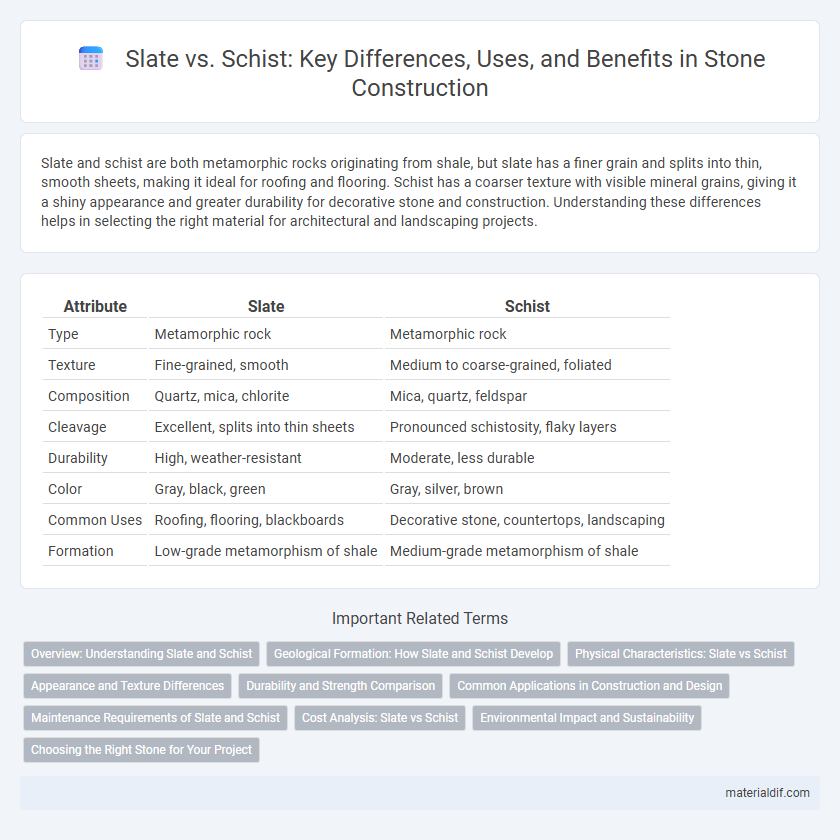Slate and schist are both metamorphic rocks originating from shale, but slate has a finer grain and splits into thin, smooth sheets, making it ideal for roofing and flooring. Schist has a coarser texture with visible mineral grains, giving it a shiny appearance and greater durability for decorative stone and construction. Understanding these differences helps in selecting the right material for architectural and landscaping projects.
Table of Comparison
| Attribute | Slate | Schist |
|---|---|---|
| Type | Metamorphic rock | Metamorphic rock |
| Texture | Fine-grained, smooth | Medium to coarse-grained, foliated |
| Composition | Quartz, mica, chlorite | Mica, quartz, feldspar |
| Cleavage | Excellent, splits into thin sheets | Pronounced schistosity, flaky layers |
| Durability | High, weather-resistant | Moderate, less durable |
| Color | Gray, black, green | Gray, silver, brown |
| Common Uses | Roofing, flooring, blackboards | Decorative stone, countertops, landscaping |
| Formation | Low-grade metamorphism of shale | Medium-grade metamorphism of shale |
Overview: Understanding Slate and Schist
Slate and schist are both metamorphic rocks that form under different conditions, with slate developing from low-grade regional metamorphism and schist forming under higher temperatures and pressures. Slate is characterized by its fine-grained texture and excellent foliation, making it ideal for roofing and flooring, while schist displays a coarser grain due to visible mineral crystals such as mica, garnet, or chlorite. Understanding their mineral composition and formation process helps distinguish slate's durability and smooth surface from schist's layered appearance and flexibility in architectural applications.
Geological Formation: How Slate and Schist Develop
Slate forms from the low-grade metamorphism of shale, resulting in fine-grained foliation due to the recrystallization of clay minerals under relatively low temperature and pressure conditions. Schist develops through medium to high-grade metamorphism, where increased temperature and pressure cause the growth of visible mica and other platy minerals, creating a coarser foliation and pronounced schistosity. The distinct metamorphic conditions of slate and schist reflect their geological formation processes within regional metamorphic environments.
Physical Characteristics: Slate vs Schist
Slate exhibits a fine-grained, foliated texture with smooth, flat surfaces ideal for roofing tiles and flooring, while schist features a coarser, more visibly foliated structure with pronounced mineral grains such as mica and quartz. Slate's low porosity and excellent cleavage make it durable and water-resistant, whereas schist's higher porosity and variable cleavage reduce its suitability for high-wear applications. The crystal alignment in slate results from low-grade metamorphism of shale, contrasting with the higher-grade metamorphic origin of schist that produces its characteristic sparkly appearance and thicker foliated layers.
Appearance and Texture Differences
Slate features a fine-grained, smooth surface with a consistent, flat texture ideal for roofing and flooring, while schist exhibits a coarser, flaky texture with visible mineral grains such as mica and garnet. Slate's uniform, dark colors contrast with schist's varied hues and shiny, layered appearance caused by its foliated structure. The distinct cleavage in slate allows for clean, thin splitting, whereas schist breaks irregularly due to its more pronounced mineral alignment.
Durability and Strength Comparison
Slate exhibits superior durability and strength compared to schist due to its dense, fine-grained structure and foliation, which provides excellent resistance to weathering and mechanical stress. Schist, characterized by its larger, flaky mineral grains, tends to be less robust and more prone to splitting under pressure. The compact crystalline structure of slate makes it ideal for roofing and flooring applications where long-term resilience is crucial.
Common Applications in Construction and Design
Slate is widely used in roofing, flooring, and wall cladding due to its durability, water resistance, and fine-grained texture that allows clean, smooth cuts. Schist, known for its pronounced foliated texture and gemstone inclusions like garnet or staurolite, is commonly applied in decorative veneers, landscaping, and interior design accents where aesthetic appeal is prioritized. Both stones offer distinct visual and structural benefits, with slate favored for functional construction elements and schist chosen for ornamental purposes.
Maintenance Requirements of Slate and Schist
Slate requires minimal maintenance due to its dense, non-porous structure that resists moisture, stains, and cracks, making it ideal for roofing and flooring. Schist, characterized by its foliated texture and higher susceptibility to flaking, demands more frequent sealing and periodic inspections to prevent water penetration and surface degradation. Overall, slate offers greater longevity and lower upkeep costs compared to schist when used in construction and decorative applications.
Cost Analysis: Slate vs Schist
Slate generally costs between $4 to $9 per square foot, making it a more affordable option for roofing and flooring compared to schist, which typically ranges from $6 to $12 per square foot due to its unique mineral composition and durability. Installation costs for both stones vary, but schist may incur higher labor expenses because of its heavier weight and irregular texture. When factoring in long-term maintenance and replacement, slate offers a cost-effective solution with its proven longevity and low porosity, whereas schist's higher price is often justified by its aesthetic appeal and resistance to weathering.
Environmental Impact and Sustainability
Slate exhibits lower environmental impact compared to schist due to its denser composition and less intensive quarrying processes, which results in reduced habitat disruption and lower energy consumption. Schist's flaky structure often requires more extensive extraction and processing, increasing carbon emissions and waste generation. Opting for slate as a sustainable building material supports eco-friendly construction by minimizing resource depletion and promoting longer-lasting applications.
Choosing the Right Stone for Your Project
Slate offers a fine-grained, smooth surface ideal for roofing and flooring, characterized by its excellent cleavage and durability. Schist features a coarser, foliated texture with visible mineral grains, making it suitable for decorative stonework and landscaping accents. Selecting between slate and schist depends on the specific project requirements, such as aesthetic preference, structural strength, and environmental exposure.
Slate vs Schist Infographic

 materialdif.com
materialdif.com